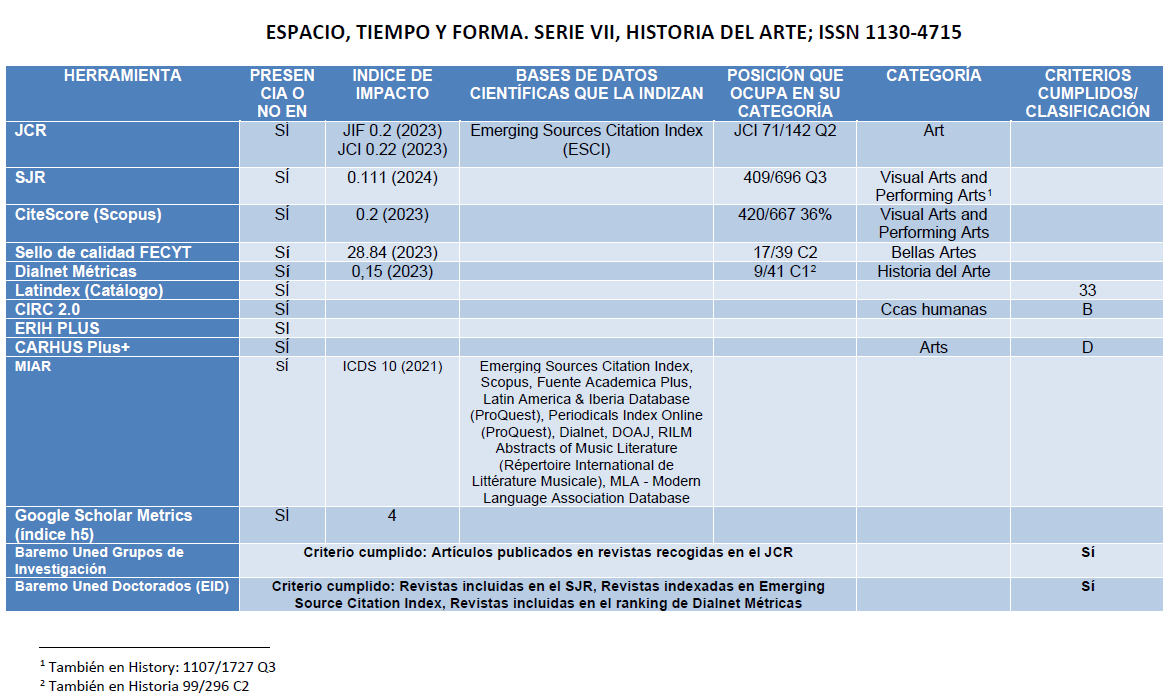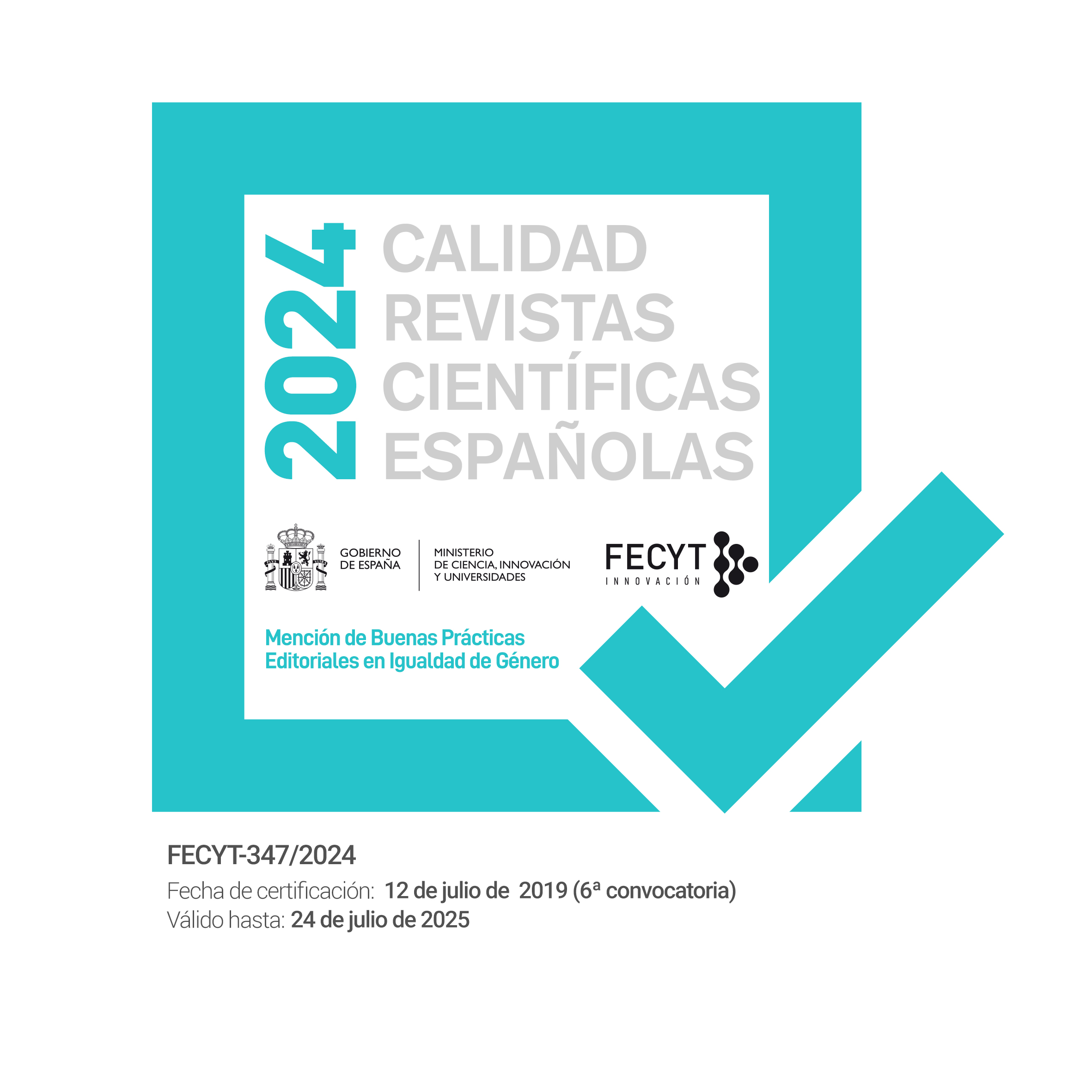About the Journal
Focus and Scope
Editorial Policy
The journal welcomes previously unpublished articles relating to Art History, particularly works that provides an innovative approach to the interpretation of the objects of study proposed and their methodological focus, contribute to its field of research, and offer a critical analysis. Submissions in Spanish or a foreign language (preferably English) are open to scholars worldwide.
ETF, Serie VII only considers original articles that have not already been published, nor will be published elsewhere, either partially or fully, in Spanish or any other language.
Composition of the Journal
The journal is composed by two sections, a miscellany of articles that are submitted and subject to external review, and a themed issue containing papers by guest authors as well as successful submissions received in response to the call for papers (also subject to external review). In addition, the journal may include reviews of books, which will be considered by the Editorial Board.
Themed issues
Each issue will preferably include a special themed issue coordinated by an expert appointed by the Editorial Board (with the approval of the Committee of the Department of Art History), who will be responsible for commissioning contributions for the issue and circulating a thematic call for papers. The contributions by guest authors, which must not exceed two articles, are not subject to peer review; however, the Editorial Board will oversee the quality of the contributions. The papers submitted in response to the call for papers are always subject to external review.
Peer Review Process
The Peer Review System
a) The articles included in the miscellany section are always subject to external review and evaluation.
b) The articles received in response to the call for papers and included in the themed issues are always subject to external review and evaluation.
The following process will be applied to all papers subject to external review and evaluation:
1. Manuscript submission
The Editor or Editors will assign the manuscript to a member of the Editorial Board who will serve as a rapporteur.
2. In-House Screening
The rapporteur will review the manuscript to assess its originality, relevance, and whether it fits the journal’s aims and thematic scope. Negative responses will provide well-grounded reasons for exclusion.
3. External review and evaluation
Following a positive assessment of the manuscript, the rapporteur will choose two external experts in the field related to the subject of the manuscript to review the article. External evaluation is conducted through a predetermined questionnaire. If the external evaluations are divergent, the Editorial Board could choose a third review. Review is double-blind (neither the reviewers nor the authors are aware of each other’s identities). Reviews also remain anonymous to the members of the Editorial Board, with the exception of the rapporteur and the Editor. The reviewers can reject the manuscript, request revisions, accept the manuscript for publication with suggestions or revisions, or, lastly, accept it for publication with no changes required. Corrections must be detailed and are strongly encouraged to help improve the quality of the manuscripts. A third reviewer will be sought if the two revisions diverge significantly. Communication between the reviewers and the author will be conducted through the Editorial Board. If corrections are advised, the reviewers may re-examine the manuscript once the amendments have been made.
Regarding the themed issued, if the volume of papers received is very high, the Editorial Board could look for highly specialised reviewers who could receive an economic compensation.
4. Editorial decision
The rapporteur will then present the external reviewers’ reports and the corrections made by the authors to the Editorial Board who will accept or reject the manuscript. The final decision is made by the Editorial Board in its condition as a collegiate body. The author will receive a reasoned, well-grounded response, including the reviewers’ comments. The authors will be informed of the Editorial Board’s decision within a period which may not be longer than three months after the submission.
Publication Frequency
The journal is published annually. The journal enters a new era in 2013 and is being renumbered from issue n. 1.
Open Access Policy
The journal provides immediate, open access to its content under the principle of providing the public with no-cost access to research, thereby promoting the exchange of knowledge on a global scale.
Reviewers
Espacio, Tiempo y Forma. Serie VII. Historia del Arte, publishes the list of the Reviewers having authorized the publication of their names two issues after the paper reviewed.
Relación de evaluadores/as de ETFVII, Nueva Época
If you would like to be included in ETF Journal’s Reviewer Database, send your CV to serie7.revista-etf@geo.uned.es and the Editorial Board will consider it for inclusion.
Complaints and Suggestions
If you are a reader, author or reviewer and have a complaint or suggestion to make to ETF. Serie VII, please send an e-mail to revista-etf@geo.uned.es. Committed to quality standards, the journal’s Editorial Board and/or Editorial Committee will respond to your e-mail.
Organization Chart
Advisory Board
Composed by external specialists on the field, the Advisory Board will establish the theoretical editorial policy and supervise its development.
Editorial Committee
It is an executive organ which takes the editorial decisions and makes the first analyses of the submissions. The decisions will be approved by agreement or vote after the grounded proposal of the rapporteur, and always with the support of two or three external blind-reviews which will be analysed by the Editorial Committee.
The Editorial Committee is composed by Ph. D. researchers who will act as rapporteurs. One of these researchers will act as Director of the Editorial Committee and others as editors. Besides, the themed dossier will have as editor the person who has proposed the appointment of the coordinator. The members of the Editorial Committee will be responsible for the management of the journal, checking of the page proofs, website management, communications with the authors, as well as corrections and style suggestions for the authors.
The Editorial Committee will be responsible for the decisions regarding the topics of the themed dossiers of the journal and for selecting potential invited coordinators for the dossier. Both decisions will be supervised by the Committee of the Department.
The composition of the Editorial Committee must be approved by the Committee of the Department of Art History and may be open to Ph. D. researchers of other academic institutions. Unless the Committee of the Department of Art History reaches a different agreement, the Director of the Department (or a delegated member) will be the Director of the Editorial Committee. Every two years the Editorial Committee will renovate its members in a session of the Committee of the Department of Art History.
Statistics
NÚMERO 1, 2013. NUEVA ÉPOCA
Artículos presentado /Articles submitted: 42
Aceptados /Accepted: 16 (38%)
Rechazados / Rejected: 26 (62%)
Filiación institucional de los/as autores/as de los artículos publicados
Institutional affiliations of the authors of the articles published:
De la misma institución editora: 1 (6 %)
Authors affiliated with the publishing body
Externos a la institución editora: 15 (94 %)
External authors not affiliated with the publishing body
Periodo de contestación a los/as autores/as desde el envío del artículo hasta la aceptación o rechazo:
Journal response time (since the submission of an article until its acceptance or rejection):
Menos de tres meses: 3 (18,75 %)
Less than three months
Entre tres y seis meses: 13 (81,25%)
Between three and six months
Más de seis meses: 0
More than six months
NÚMERO 2, 2014. NUEVA ÉPOCA
Artículos presentados /Articles submitted: 15
Aceptados /Accepted: 6 (40 %)
Rechazados / Rejected: 9 (60 %)
Filiación institucional de los/as autores/as de los artículos publicados:
Institutional affiliations of the authors of the articles published:
De la misma institución editora: 0 (0 %)
Authors affiliated with the publishing body
Externos a la institución editor: 6 (100 %)
External authors not affiliated with the publishing body
Periodo de contestación a los/as autores/as desde el envío del artículo hasta la aceptación o rechazo
Journal response time (since the submission of an article until its acceptance or rejection):
Menos de tres meses: 1 (16,6 %)
Less than three months
Entre tres y seis meses: 4 (66,8 %)
Between three and six months
Más de seis meses: 1 (16,6 %)
More than six months
NÚMERO 3, 2015. NUEVA ÉPOCA.
Artículos presentados /Articles submitted: 22
Aceptados /Accepted: 14 (64 %)
Rechazados / Rejected: 8 (36 %)
Filiación institucional de los/as autores/as de los artículos publicados:
Institutional affiliations of the authors of the articles published:
De la misma institución editora: 2 (14%)
Authors affiliated with the publishing body
Externos a la institución editora: 12 (86 %)
External authors not affiliated with the publishing body
Periodo de contestación a los/as autores/as desde el envío del artículo hasta la aceptación o rechazo:
Journal response time (since the submission of an article until its acceptance or rejection):
Menos de tres meses: 9 (41%)
Less than three months
Entre tres y seis meses: 6 (27%)
Between three and six months
Más de seis meses: 7 (32 %)
More than six months
Preservation policy
Digital preservation is understood as a set of processes and activities that ensure that information currently existing in digital formats is backed up and distributed to guarantee long-term, continuous access. It is supported by the services of the UNED's CSI (Computer Services Center), which is responsible for preservation through backups.
Furthermore, the journal is part of the private LOCKSS network of the Public Knowledge Project (PKP-PLN): https://portal.issn.org/resource/ISSN/2340-1478
The preservation policy also includes the assignment of DOIs to the journal title, each issue, and each article.
Indexing and Databases
The quality of Space, Time and Form. Series VII, History of Art is supported by impact indices and metrics compiled annually by various national and international agencies and databases.
Below is the table prepared by the UNED Library with all the indicators for 2024, the last year evaluated:

Adoption Credit rols taxonomy
As part of our commitment to ensuring an ethical, transparent, and fair publication and peer review process ETFVI has adopted the CRediT Taxonomy to describe each author’s individual contributions to the work.
CRediT (Contributor Roles Taxonomy) was introduced with the intention of recognizing individual author contributions, reducing authorship disputes and facilitating collaboration
CRediT offers authors the opportunity to share an accurate and detailed description of their diverse contributions to the published work.
The submitting author of the manuscript submission is responsible for providing the contributions of all authors at the time of submission. We hope that all authors have reviewed, discussed and accepted their individual contributions before this date. Contributions will be published with the final article and must accurately reflect contributions to the work.








